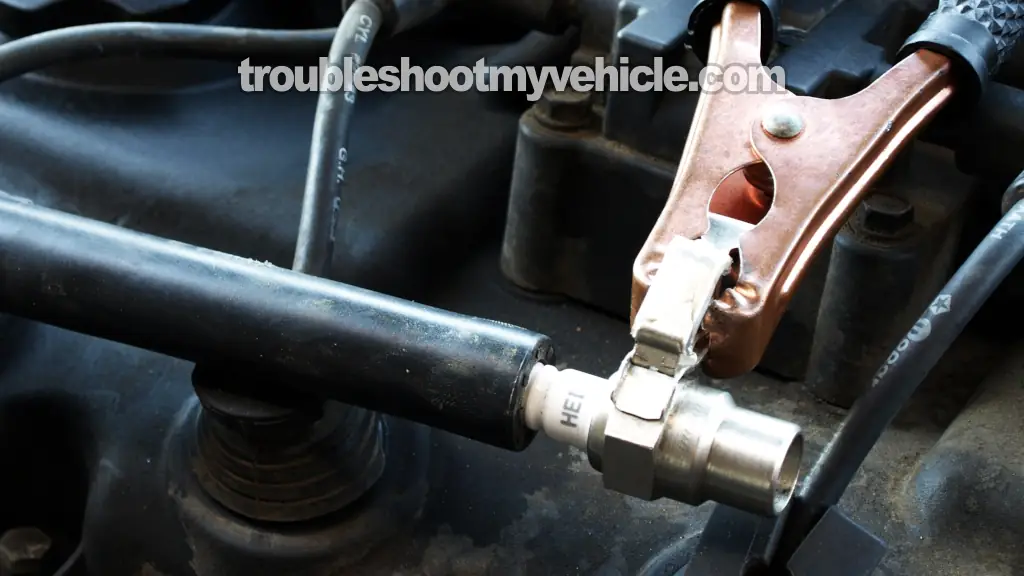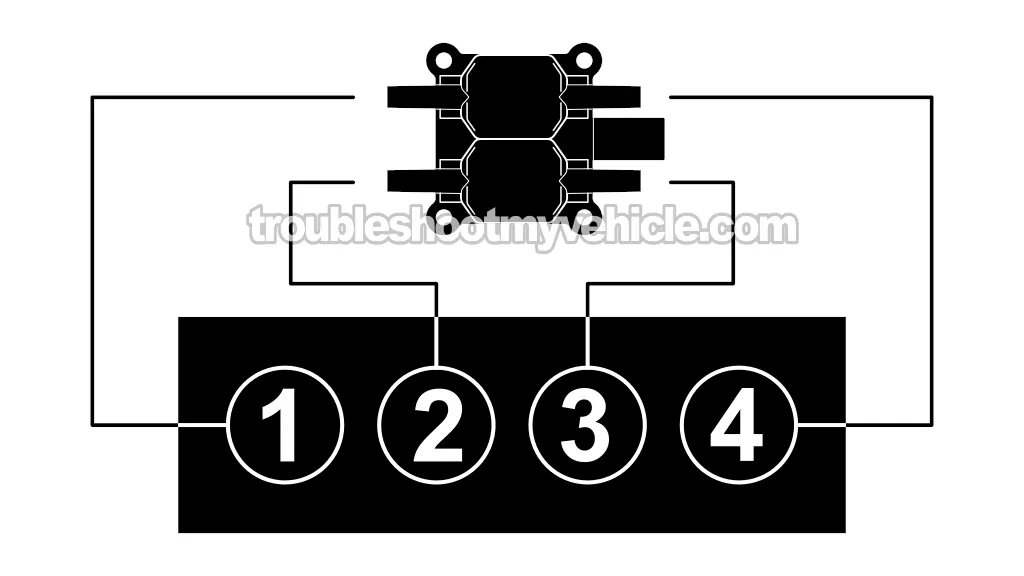
The ignition system of the 1995-2000 2.0L Dodge Stratus (Plymouth Breeze) uses an ignition coil pack that can be easily tested with a few simple tools.
In this tutorial, I'll show you how to determine if it's good or bad. You'll quickly find out if a bad coil pack is causing a cylinder misfire issue or an engine no-start problem.
All of the ignition coil tests are explained step by step.
Contents of this tutorial:
- Symptoms Of A Bad Ignition Coil.
- Ignition Coil Connector Circuit Descriptions.
- What Tools Do I Need?
- Waste Spark Ignition System Basics.
- TEST 1: Checking All Four Spark Plug Wires For Spark.
- TEST 2: Testing For Spark At The Ignition Coil Pack.
- TEST 3: Testing For Spark At The Ignition Coil Pack (Paired Cylinders).
- TEST 4: Testing For Spark At The Ignition Coil Pack (Non-Paired Cylinders).
- TEST 5: Making Sure The Coil Pack Is Getting 12 Volts.
- TEST 6: Checking The Activation Signal For Cylinders 1 And 4.
- TEST 7: Checking The Activation Signal For Cylinders 2 And 3.
- TEST 8: Making Sure The Ignition Coil Pack Is Getting Its Activation Signals.
- Other Possible Misfire Causes.
 You can find this tutorial in Spanish here: Cómo Probar La Bobina De Encendido (1995-2000 2.0L Dodge Stratus, Plymouth Breeze) (at: autotecnico-online.com).
You can find this tutorial in Spanish here: Cómo Probar La Bobina De Encendido (1995-2000 2.0L Dodge Stratus, Plymouth Breeze) (at: autotecnico-online.com).
APPLIES TO: This tutorial applies to the following vehicles:
- 2.0L Dodge Stratus: 1995, 1996, 1997, 1998, 1999, 2000.
- 2.0L Plymouth Breeze: 1996, 1997, 1998, 1999, 2000.
Symptoms Of A Bad Ignition Coil
Typically, the ignition coil fails in one of two ways. It either stops creating spark for a single cylinder, or it stops creating spark for two or more cylinders. You may experience one or more of the following symptoms:
- Cylinder misfire: This can cause the engine to run rough at idle and you'll definitely feel the misfire when you accelerate.
- Check engine light on: The check engine light will illuminate when an ignition coil pack fails.
- Misfire trouble codes: You'll see one or more of the following cylinder misfire trouble codes:
- P0300: Random Cylinder Misfire.
- P0301: Cylinder #1 Misfire.
- P0302: Cylinder #2 Misfire.
- P0303: Cylinder #3 Misfire.
- P0304: Cylinder #4 Misfire.
- Rough idle: The engine may vibrate or shake excessively at idle.
- Reduced power: The engine may not produce as much power as it normally does.
- Bad gas mileage: The vehicle may get worse gas mileage than usual.
- Engine doesn't start: This is the worst case scenario and happens when the ignition coil pack stops creating and supplying spark to two or more cylinders.
Ignition Coil Connector Circuit Descriptions
| Wire | Color | Description |
|---|---|---|
| 1 | Dark blue with dark green stripe (DK BLU/DK GRN)* | Ignition Control Signal - Cylinders 1 And 4 |
| 2 | Dark green with orange stripe (DK GRN/ORG) | Sensor Ground |
| 3 | Black with grey stripe (BLK/GRY) | Ignition Control Signal - Cylinders 2 And 3 |
* In some vehicles, this wire is a dark blue with tan stripe (DK BLU/TAN) wire.
What Tools Do I Need?
To troubleshoot the ignition coil pack, you'll need a few basic tools. Here's the list:
- A spark tester.
- You can use any spark tester your used to using, the one that I use and always recommend (for its ease of use and accuracy) is the HEI spark tester (by OTC).
- You can see an example of the HEI spark tester and where to buy it here: The HEI Spark Tester (The Best Spark Tester On the Market) (at: easyautodiagnostics.com).
- A multimeter.
- An LED light.
- You can see an example of this tool here and where to buy it: The LED Light Test Tool And How To Make One (at: easyautodiagnostics.com).
- Battery jump start cables.
- Someone to help you crank the car.
Waste Spark Ignition System Basics
In this tutorial, you'll come across the terms "paired cylinders" and "non-paired cylinders." To effectively diagnose your ignition coil pack, you need to know what these terms mean. The starting point is understanding that your Stratus (or Breeze) uses a "waste-spark" ignition system.
In a "waste-spark" ignition system, the ignition coil pack is made up of two individual ignition coils. One ignition coil is responsible for firing two spark plugs simultaneously, while the other individual coil takes care of the remaining cylinders.
The engine cylinders that get spark at the exact same time are called "paired cylinders". In your 2.0L Dodge Stratus (Plymouth Breeze) this means that:
- Cylinders #1 and #4 are "paired cylinders".
- Cylinders #2 and #3 are "paired cylinders".
Here's a quick rundown of how the "waste-spark" system works: The two spark plugs that fire simultaneously are connected to cylinders that are opposite in their firing order. So, when one cylinder is in its compression stroke, the other is in its exhaust stroke.
The term "waste-spark" comes from the idea that one of the sparks is "wasted" on the cylinder that's on its exhaust stroke, where no combustion occurs. Despite the term, this system is not only efficient but less complex, with fewer parts than a traditional mechanical distributor system that could wear out, fail, or need replacement. While it might seem like that extra spark is "wasted," it doesn't harm the system and ensures all cylinders get the spark they need.
So, when you're dealing with "paired cylinders", you're essentially looking at two cylinders that get spark at the same time —one doing useful work (compression stroke) and the other not so much (exhaust stroke). On the other hand "non-paired cylinders", are any two cylinders that DO NOT get spark at the same time.
TEST 1: Checking All Four Spark Plug Wires For Spark

To get our ignition coil pack diagnostic going, we'll test all four spark plug wires for spark using a spark tester.
The spark test involves disconnecting one spark plug wire at a time, attaching a spark tester to it, and then cranking the engine to see if the tester sparks.
I want to emphasize the importance of using a dedicated spark tester for an accurate spark test result. Relying on any other method might lead you to a wrong diagnosis, resulting in replacing parts that don't solve the issue. While any spark tester will do, the one I personally recommend and use is the HEI Spark Tester by OTC.
You can see an example of the OTC HEI spark tester and where to buy it here: The HEI Spark Tester (The Best Spark Tester On the Market) (at: easyautodiagnostics.com)
CAUTION: The spark test involves cranking the engine! Be careful and take all necessary precautions when working around a cranking engine.
Let's get started:
- 1
Remove the spark plug wire (high tension cable) from the cylinder #1 spark plug.
- 2
Attach the spark tester to the spark plug wire.
- 3
Ground the spark tester with a battery jump start cable.
Connect the spark tester to a clean metal surface on the engine or directly on the battery negative (-) terminal. - 4
Have your helper crank the vehicle while you keep you eye on the spark tester.
NOTE: The vehicle may or may not start, either way be careful. - 5
You're gonna get one of two results: Spark or no spark.
- 6
Now repeat this test on the other cylinders.
Let's take a look at what your test results mean:
CASE 1: You got spark from all four spark plug wires. This is the correct test result. You can conclude that the ignition coil pack and spark plug wires are OK.
The cause of your misfire condition is not due to a bad ignition coil pack. Go to: Other Possible Misfire Causes to see further tips and suggestions.
CASE 2: You got NO spark from only one spark plug wire. The next step is to check for spark directly on the ignition coil pack tower that feeds spark to that non-sparking spark plug wire. Go to: TEST 2: Testing For Spark At The Ignition Coil Pack.
CASE 3: You got NO spark from two spark plug wires that connect to paired cylinders (1 and 4 or 2 and 3). The next step is check for spark directly on the ignition coil pack towers that feed those spark plug wires with spark, go to: TEST 3: Testing For Spark At The Ignition Coil Pack (Paired Cylinders).
CASE 4: You got NO spark from two spark plug wires that DO NOT connect to paired cylinders. The next step is check for spark directly on the ignition coil pack towers that feed those spark plug wires with spark, go to: TEST 4: Testing For Spark At The Ignition Coil Pack (Non-Paired Cylinders).
CASE 5: You got NO spark from none of the spark plug wires. This usually indicates that the ignition coil pack is not getting power or that the crankshaft position sensor is bad.
Your next step is to make sure that the ignition coil pack is getting 10 to 12 Volts. For this test go to: TEST 5: Making Sure The Coil Pack Is Getting 12 Volts.




